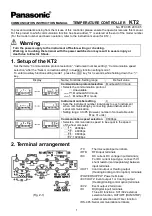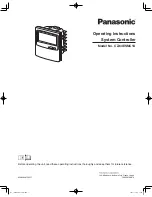
22
System Wiring
© 2011 Apollo Security Inc.
Figure 3.6 Input Supervision.
The AIM-4SL reader inputs can be configured for Supervised or
Unsupervised. End of line resistors must be used in the supervised configuration in order for the circuits to
report the correct state.
3.6.2
Door Contact Input (Door Position Switch)
This is a normally closed input and should have a jumper installed if not used!
Terminal connectors: DC, DCR (See Table 2.1 )
The door contact input is a normally closed input used to monitor the open/closed status of the door. This will
typically be connected to a magnetic sensor in the frame of the door that will provide a short circuit when the
door is closed and an open circuit when the door is opened. If input supervision is enabled (see Part 3.6.1
above), end of line terminating resistors must be installed. The terminating resistors should be installed at
the door contact end (not the reader end) of the cable.
The reader will use this input to detect when the door is opened and when the door is closed. This
information is processed by the reader and used to generate certain alarm messages. If a door is detected to
be opened for no apparent reason (not as a result of a valid card or PIN use or exit button activation), the
reader will generate a “Forced Open” message. If the door is opened as a result of a valid access request or
exit button activation but not allowed to close within the programmed held open time, a “Held Open” alarm
will be generated.
The reader may also be configured from the host software to allow early strike relay shutoff. Normally the
amount of time that the reader will keep the strike relay activated is controlled by the “Strike Time” setting in
the host computer. This is the amount of time a person has to open the door after being granted access.
This time is adjustable from 0 to 255 seconds (0 = ½ second). If the strike time is configured for 10 seconds
(for example) and the person has already opened and closed the door after 5 seconds, the reader may be
configured to terminate the normal 10 second strike time early (thus not allowing the door to be opened
twice). If the reader is configured for this early strike shutoff option, it is important that the door contact input
is working properly. If the input is not connected or is malfunctioning and the reader detects that the door is
always open, erroneous alarms will be generated and the Strike Time will always be very short (the reader
thinks the people are opening the door quickly), resulting in it being impossible to open the door.
3.6.3
Exit Pushbutton Input (Request To Exit, REX)
The Exit Pushbutton input will be disabled during Reader Tamper and for 1 minute after tamper
condition ends!
Terminal Connectors: EPB, EPBR (See Table 2.1 )
The Exit Pushbutton input is used by the reader to inform the reader of a door opening without first using the
card / PIN. Normally, if the reader detects a door open condition without valid use of card or PIN, it will
generate a “Forced Open” alarm. This alarm must be masked (inhibited) when people use the door to exit
from the inside of any secured area. The Exit Pushbutton input is used for this purpose. After detecting a
closed circuit of the Exit Pushbutton input, the reader will ignore the door contact input for a period of time
equal to the strike time set for the reader. This allows the people to then open the door for exit without an
alarm being generated.
In some situations the Exit Pushbutton input should also close the strike relay to allow the door to be opened
from the inside. This feature is configured in the host software. The reader can be programmed to only mask
the forced open alarm, or to activate the strike relay and mask the forced open alarm. Use of PIR motion exit
devices require that special care be taken in regards to activation of the strike relay. If the reader is
configured for activation of strike relay on exit, and a PIR is installed on the interior side of the door for
automatic exit activation, if a foreign object is slid under the door from the unsecured side and moved
around, the PIR may be activated. This will mask off all door alarms and release the strike relay, allowing
unauthorized entry. Use of Fail Secure Strikes (require power to hold door closed) or Magnetic type locks
generally will require activation of the strike relay.
Most local fire codes require that exit must be obtainable from all doors regardless of proper operation of the
Summary of Contents for AIM-4SL
Page 6: ...Part Introduction I ...
Page 9: ...Part Hardware Layout II ...
Page 19: ...Part System Wiring III ...
Page 36: ...Part Troubleshooting IV ...
Page 38: ...Part Specifications V ...
Page 40: ...Part Supplemental Figures VI ...
Page 41: ...36 Supplemental Figures 2011 Apollo Security Inc 6 Supplemental Figures ...
Page 42: ...37 AIM 4SL Hardware Manual 2011 Apollo Security Inc ...
Page 43: ...38 Supplemental Figures 2011 Apollo Security Inc ...
Page 44: ...39 AIM 4SL Hardware Manual 2011 Apollo Security Inc ...
Page 45: ...40 Supplemental Figures 2011 Apollo Security Inc ...
Page 46: ...41 AIM 4SL Hardware Manual 2011 Apollo Security Inc ...
Page 47: ...42 Supplemental Figures 2011 Apollo Security Inc ...
Page 48: ...Part Table of Figures VII ...
Page 50: ...Part Revision History VIII ...
















































